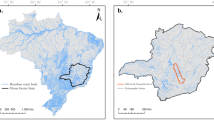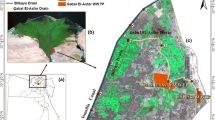Abstract
Remote sensing is an important tool for environmental assessment, especially in the event of disasters such as the tailings dam burst at the Córrego do Feijão mine, located in the Paraopeba River basin, Brazil. Thus, this study aimed to carry out a spectro-temporal analysis of the Paraopeba River water given the dam burst, using multispectral images from the MSI sensor onboard Sentinel-2 satellites. For this analysis, sections along the river were defined by the creation of buffers, with 10-km intervals each, starting from the origin of the burst. For each section, the average visible to near-infrared (NIR) reflectance values per band and the Normalized Difference Water Index (NDWI) were obtained. We found that the red edge and NIR bands (B5, B6, B7, B8, and B8A) showed higher reflectance values when compared to the visible bands in the months immediately after the disaster, especially in the first 20 km. In these months, negative NDWI values were also found for almost all sections downstream, demonstrating the large volume of mining tailings in the Paraopeba River. The seasonal variation of the observed values indicates the resuspension of the material deposited at the river bottom with the beginning of the rainy season. Finally, we highlight the usefulness of the MSI/Sentinel-2 red edge and NIR bands for further studies on the monitoring from space of water bodies subjected to contamination by large amounts of mud with iron ore tailings and contaminants, as occurred in the state of Minas Gerais, southeastern Brazil.







Similar content being viewed by others
Data availability
The database used in this manuscript is freely available at the EarthExplorer Portal (https://earthexplorer.usgs.gov/), developed by the US Geological Survey (USGS). The datasets generated during and/or analyzed during the current study are available from the corresponding author on reasonable request.
References
Aires, U. R. V., Santos, B. S. M., Coelho, C. D., da Silva, D. D., & Calijuri, M. L. (2018). Changes in land use and land cover as a result of the failure of a mining tailings dam in Mariana, MG, Brazil. Land Use Policy, 70(2017), 63–70. https://doi.org/10.1016/j.landusepol.2017.10.026
Almeida, D. N. O., de Oliveira, L. M. M., Candeias, A. L. B., Bezerra, U. A., & Leite, A. C. de S. (2018). Uso e cobertura do solo utilizando geoprocessamento em municípios do Agreste de Pernambuco. Revista Brasileira de Meio Ambiente.
Almeida, L. T., Silva, F. B., Fraga, M. D. S., Ribeiro, R. B., Ramos, M. C. A., & Cecílio, R. A. (2019). Análise da comportamento espectral da água do Rio Doce, Brasil, mediante o rompimento da barragem de sedimentos da empresa SAMARCO. Revista Tecnología en Marcha, 32, 36–42. https://doi.org/10.18845/tm.v32i7.4257
ALMG. (2019). CPI da Barragem de Brumadinho Relatório Final.
Alvares, C. A., Stape, J. L., Sentelhas, P. C., De Moraes Gonçalves, J. L., & Sparovek, G. (2013). Köppen’s climate classification map for Brazil. Meteorologische Zeitschrift, 22(6), 711–728. https://doi.org/10.1127/0941-2948/2013/0507
ANM. (2019). Relatório anual de seguranças de barragens de mineração 2019. Relatório anual de seguranças de barragens de mineração 2019.
Bezerra, B. G., Silva, L. L., & Santos e Silva, C. M., & de Carvalho, G. G. (2019). Changes of precipitation extremes indices in São Francisco River Basin, Brazil from 1947 to 2012. Theoretical and Applied Climatology, 135(1–2), 565–576. https://doi.org/10.1007/s00704-018-2396-6
Borges, R. de O., Camargo, F. F., Campagnoli, F., & Bayer, M. (2015). Aplicação do índice da diferença normalizada da água (NDWI) na delimitação de fluxos de sedimentos em suspensão no Rio Araguaia: avaliação das imagens Landsat 8 para o monitoramento hidroviário. Anais XVII Simpósio Brasileiro de Sensoriamento Remoto, 6022–6029.
Carmo, F. F., do Kamino, L. H. Y., Junior, R. T., Campos, I. C., de Carmo, F. F., do Silvino, G., et al. (2017). Fundão tailings dam failures: The environment tragedy of the largest technological disaster of Brazilian mining in global context. Perspectives in Ecology and Conservation, 15(3), 145–151. https://doi.org/10.1016/j.pecon.2017.06.002
CBHSF. (2019). CBH do Rio Paraopeba (SF3)—MINAS GERAIS. CBH do Rio Paraopeba (SF3). Minas Gerais.
Da Cunha, C. F., Cardoso, S. B., Teramoto, E. H., & Chang, H. K. (2020). Modelo área-volume para a Represa Guarapiranga empregando o índice NDWI. Holos Environment, 20(1), 137–151. https://doi.org/10.14295/holos.v20i1.12370
Deng, X., Song, C., Liu, K., Ke, L., Zhang, W., Ma, R., et al. (2020). Remote sensing estimation of catchment-scale reservoir water impoundment in the upper Yellow River and implications for river discharge alteration. Journal of Hydrology, 585. https://doi.org/10.1016/j.jhydrol.2020.124791
DeVries, B., Huang, C., Armston, J., Huang, W., Jones, J. W., & Lang, M. W. (2020). Rapid and robust monitoring of flood events using Sentinel-1 and Landsat data on the Google Earth Engine. Remote Sensing of Environment, 240 (2019). https://doi.org/10.1016/j.rse.2020.111664
Ehmann, K., Kelleher, C., & Condon, L. E. (2019). Monitoring turbidity from above: Deploying small unoccupied aerial vehicles to image in-stream turbidity. Hydrological Processes, 33(6), 1013–1021. https://doi.org/10.1002/hyp.13372
Fernandes, M. S. (2016). Uso do Sensoriamento Remoto Para Análise Espacial e Temporal de Sedimentos em Suspensão no Reservatório do APM Manso (Mt). Universidade Federal de Santa Catarina.
Florenzano, T. G. (2011). Iniciação em sensoriamento remoto (3. ed.). São Paulo.
Huang, X., Liu, J., Zhang, Z., Fang, G., & Chen, Y. (2019). Assess river embankment impact on hydrologic alterations and floodplain vegetation. Ecological Indicators, 97(2018), 372–379. https://doi.org/10.1016/j.ecolind.2018.10.039
IGAM. (2019a). Boletim Informativo do cidadão Qualidade da Água no Rio Paraopeba No03, Setembro(03).
IGAM. (2019b). Boletim Informativo do cidadão Qualidade da Água no Rio Paraopeba No06.
IGAM. (2020). Boletim Informativo do cidadão Qualidade da Água no Rio Paraopeba No07, Janeiro(07).
Im, J., Park, H., & Takeuchi, W. (2019). Advances in remote sensing-based disaster monitoring and assessment. Remote Sensing, 11(18), 9–12. https://doi.org/10.3390/rs11182181
INMET. (2019). Normais climatológicas do Brasil. Normais climatológicas do Brasil.
Jensen, J. R. (2015). Introductory digital image processing: a remote sensing perspective (4. th.).
Kaku, K. (2019). Satellite remote sensing for disaster management support: A holistic and staged approach based on case studies in Sentinel Asia. International Journal of Disaster Risk Reduction. https://doi.org/10.1016/j.ijdrr.2018.09.015
Kim, D., Lee, H., Jung, H. C., Hwang, E., Hossain, F., Bonnema, M., et al. (2020). Monitoring river basin development and variation in water resources in transboundary Imjin River in North and South Korea using remote sensing. Remote Sensing, 12(1). https://doi.org/10.3390/RS12010195
Köppen, W. (1936). Das geographische System der Klimate. Gebruder Borntrager, 1, 1–44.
Kossoff, D., Dubbin, W. E., Alfredsson, M., Edwards, S. J., Macklin, M. G., & Hudson-Edwards, K. A. (2014). Mine tailings dams: Characteristics, failure, environmental impacts, and remediation. Applied Geochemistry, 51, 229–245. https://doi.org/10.1016/j.apgeochem.2014.09.010
Machado, M. T. D. S., & Baptista, G. M. D. M. (2016). Sensoriamento remoto como ferramenta de monitoramento da qualidade da água do Lago Paranoá (DF). Engenharia Sanitaria e Ambiental, 21(2), 357–365. https://doi.org/10.1590/S1413-41522016141970.
Maxwell, S. K., & Sylvester, K. M. (2012). Identification of “ever-cropped” land (1984–2010) using Landsat annual maximum NDVI image composites: Southwestern Kansas case study. Remote Sensing of Environment, 121, 186–195. https://doi.org/10.1016/j.rse.2012.01.022
McFeeters, S. K. (1996). The use of the Normalized Difference Water Index (NDWI) in the delineation of open water features. International Journal of Remote Sensing, 17(7), 1425–1432. https://doi.org/10.1080/01431169608948714
Müller-Wilm, U. (2017). Sen2Cor configuration and user manual. Telespazio VEGA Deutschland GmbH, 1, 53.
Oliveira, L. V., Negri, R. G., & Santos, L. B. L. (2020). Análise de técnicas de detecção de mudança para mapeamento de desastres com uso de dados de sensoriamento remoto. Revista Brasileira de Cartografia, 72(1), 177–189. https://doi.org/10.14393/rbcv72n1-51447
Omachi, C. Y., Siani, S. M. O., Chagas, F. M., Mascagni, M. L., Cordeiro, M., Garcia, G. D., et al. (2018). Atlantic Forest loss caused by the world´s largest tailing dam collapse (Fundão Dam, Mariana, Brazil). Remote Sensing Applications: Society and Environment, 12, 30–34. https://doi.org/10.1016/j.rsase.2018.08.003
Pereira, L. F., de Barros Cruz, G., & Guimarães, R. M. F. (2019). Impactos do rompimento da barragem de rejeitos de Brumadinho, Brasil: uma análise baseada nas mudanças de cobertura da terra. Journal of Environmental Analysis and Progress, 4(2), 122. https://doi.org/10.24221/jeap.4.2.2019.2373.122-129
Pereira, M. D. G., Souza, C., Sachdev, R., Santos, A., Pinto, P., Souza, L., et al. (2017). Heavy metals in an important section of the São Francisco River (Northeast Brazil): distribution profile, accumulation mechanisms, and risks of dissemination through the food chain. Journal of Pollution Effects & Control, 05(02). https://doi.org/10.4172/2375-4397.1000193
Poursanidis, D., & Chrysoulakis, N. (2017). Remote sensing, natural hazards and the contribution of ESA Sentinels missions. Remote Sensing Applications: Society and Environment, 6(2016), 25–38. https://doi.org/10.1016/j.rsase.2017.02.001
Rotta, L. H. S., Alcântara, E., Park, E., Negri, R. G., Lin, Y. N., Bernardo, N., et al. (2020). The 2019 Brumadinho tailings dam collapse: Possible cause and impacts of the worst human and environmental disaster in Brazil. International Journal of Applied Earth Observation and Geoinformation, 90(April), 102119. https://doi.org/10.1016/j.jag.2020.102119
SOS Mata Atlântica. (2019). Observando os rios: O retrato da qualidade da água na bacia do rio Paraopeba após o rompimento da barragem Córrego do Feijão - Minas Gerais. 2019.
Tan, J., Cherkauer, K. A., & Chaubey, I. (2015). Using hyperspectral data to quantify water-quality parameters in the Wabash River and its tributaries. Indiana. International Journal of Remote Sensing, 36(21), 5466–5484. https://doi.org/10.1080/01431161.2015.1101654
Tay, C. W. J., Yun, S. H., Chin, S. T., Bhardwaj, A., Jung, J., & Hill, E. M. (2020). Rapid flood and damage mapping using synthetic aperture radar in response to Typhoon Hagibis. Japan. Scientific Data, 7(1), 1–9. https://doi.org/10.1038/s41597-020-0443-5
Thompson, F., de Oliveira, B. C., Cordeiro, M. C., Masi, B. P., Rangel, T. P., Paz, P., et al. (2020). Severe impacts of the Brumadinho dam failure (Minas Gerais, Brazil) on the water quality of the Paraopeba River. Science of the Total Environment, 705, 1–6. https://doi.org/10.1016/j.scitotenv.2019.135914
Toming, K., Kutser, T., Laas, A., Sepp, M., Paavel, B., & Nõges, T. (2016). First experiences in mapping lakewater quality parameters with sentinel-2 MSI imagery. Remote Sensing, 8(8), 1–14. https://doi.org/10.3390/rs8080640
USGS. (2019). USGS EROS Archive - Sentinel-2. The European Space Agency’s Multispectral Instrument on the Sentinel-2 satellite provides global (from 83 degrees north 56 degrees south latitude) 10-meter resolution, multispectral images every 10 days (2015-present).
Walker, D., Smigaj, M., & Jovanovic, N. (2019). Ephemeral sand river flow detection using satellite optical remote sensing. Journal of Arid Environments, 168(1), 17–25. https://doi.org/10.1016/j.jaridenv.2019.05.006
Washington, B., Seymour, L., Mote, T., Robinson, D., & Estilow, T. (2019). Identifying and extracting a seasonal streamflow signal from remotely sensed snow cover in the Columbia River Basin. Remote Sensing Applications: Society and Environment, 14, 207–223. https://doi.org/10.1016/j.rsase.2018.03.003
Funding
This study was partially financed (Ph.D. and M.Sc scholarship) by the Coordination for the Improvement of Higher Level Personnel (CAPES—Finance Code 001) and by the Brazilian National Council for Scientific and Technological Development (CNPq).
Author information
Authors and Affiliations
Corresponding author
Ethics declarations
Competing interests
The authors declare no competing interests.
Additional information
Publisher's Note
Springer Nature remains neutral with regard to jurisdictional claims in published maps and institutional affiliations.
Rights and permissions
About this article
Cite this article
Teixeira, D.B.d., Veloso, M.F., Ferreira, F.L.V. et al. Spectro-temporal analysis of the Paraopeba River water after the tailings dam burst of the Córrego do Feijão mine, in Brumadinho, Brazil. Environ Monit Assess 193, 435 (2021). https://doi.org/10.1007/s10661-021-09218-4
Received:
Accepted:
Published:
DOI: https://doi.org/10.1007/s10661-021-09218-4




